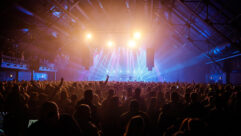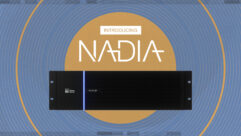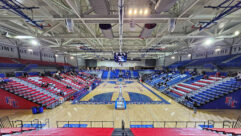In this edition of the SVC Podcast, Contributing Editor Bennett Liles finishes his interview with Euan Mackenzie of Autograph Sales and Installations in London regarding their installation of the sound system for the new Adelphi Building theater at the University of Salford in Manchester, England. Euan discusses the Sennheiser microphones, amplifiers and speakers in involved in the project.
Links of interest:
- DiGiCo’s new Stelth Core 2 software
- Sennheiser MKE2 Gold omnidirectional clip-on microphone
- Sennheiser ME4 cardioid clip-on microphone
- EM Acoustics amplifiers and speakers
Download Podcast Here:
https://s3.amazonaws.com/nb-svc/public/public/182-2_Autograph_Mackenzie_…
This is the SVC Podcast from Sound & Video Contractor Magazine with Euan MacKenzie of Autograph Sales and Installations. Show notes and equipment links for the podcast are on the web site of Sound & Video Contractor Magazine at svconline.com.
The new Adelphi Building, with its 350-seat theater at the University of Salford in Manchester, England has five different seating modes and 60 speakers to control. They have to be configured with the push of a button. Autograph Sales and Installations took on the job and Euan Mackenzie is back to finish his story on how they made all of it work. That’s coming up next on the SVC Podcast.
Euan, nice having you back with us for Part 2 on the SVC Podcast. Coming to us today from Autograph Sales and Installations in London. Your guys went up to Manchester and the University of Salford’s new Adelphi Building to completely dress it out with a new sound system. We were talking last week about the DiGiCo SD9 mixer and I think they’ve had some upgrades on that one.
Yeah, that’s right. Since the time that the console was specified and even installed initially, DiGiCo released the new Stealth Core 2 software which has basically doubled the capacity of the desk. So the desk itself, the input count has gone from 48 inputs to 96 and the amount of groups or auxes are the same thing to a DiGiCo – they’re all buses – has gone from 12 to 24. So there’s a big advantage of the extra hardware that the DiGiCo has to offer. It’s just a matter of software updates. [Timestamp: 1:44]
And of course that’s always flexible but everything there has to start with the microphones so what did you use for mics in there?
We used Sennheiser’s 500 series radio microphones, which is a must for technical theater particularly with the lavalier microphones. So for their larger musical productions they have a wealth of MKE 2 Golds and for more technical sort of speeches and talks and lectures they use the ME 4 microphones. Over and above that they’ve also got a few handhelds which are the large diaphragm condenser microphone heads, the 965’s. So I think they went to the 500’s because they’ve got some existing Sennheiser radio systems and they want this to compliment what they already had. And also being where they are, they’re not in the middle of media city. They’re not vying for RF positioning. So if somebody goes on the show outside the theatre it’s going to be the university that’s putting on that show. So they don’t have to worry about UHF congestion and analog radio mics are going to be able to do the job, particularly the 500 series from Sennheiser. They’re very nice-sounding radio mics. [Timestamp: 2:51]
Yeah, if they’re away from the madhouse of downtown London I would think that would make RF coordination a much easier job. I noticed that you used the EM Acoustics amps and speakers on this new system so what were the attractive points of those?
Yeah, I mean I’m not sure how well known EM Acoustics are in your neck of the woods, but they’ve certainly been making waves over here in recent years. We’ve had a lot of experience with EM Acoustics because they fit very well into theatre – musical theatre. The beauty of them is they sound great straight out of the box and the speakers within the range complement each other across it. So you can put a box that fits to suit the dispersion of where it needs to be and be sure that it will marry up nicely with the others in the range. The guys who head up EM Acoustics – it’s called EM because it’s Ed and Mike who are the guys who created it – and Ed’s passive crossovers, there’s something special there. It’s a bit of a work of art. Nice analog crossovers inside each of the speakers. The price certainly pays a determining factor although I’m not sure how we quite managed to install 60 speakers into the theatre and remain within budget, but we did. To give you an idea of how good they sounded we only needed to take 4 dB off at 580 Hz and that’s from the installed left and right speakers only. The rest of the system was left with the factory EM Acoustics speaker presets excluding the high-pass filters and sub EQ. They really are pretty good out of the box. Sixty speakers might sound a little excessive particularly as to how much intimate a venue it is, but not all the speakers are used for all seating layouts. So in addition to the proscenium system we needed to cover all three sides of the under balcony on all three levels so when the system is switched to in the round for a production of Hamlet, for example, every seat is still covered. We also snuck in additional side fills which were tucked in behind the main left and right speakers for when seats are on stage. And we also made those available as stage fills for when there’s no seats on the stage; another benefit of the QSYS system leading us to whatever we want to do. [Timestamp: 4:59]
Yeah, I would think that with such a wide variance of seating arrangements that having a lot of speakers would give you the control you need. It really doesn’t sound excessive to me. I’m thinking it would be great to have that.
It’s more about coverage and even amplitude and frequency across the venue. So there’s a limit to how many speakers you can put in before you start introducing more artifacts with time alignment issues and making your job harder than it needs to be. But being able to mute the speakers that we don’t need and reconfigure the delay within a snapshot makes everything very, very simple. [Timestamp: 5:33]
I was going to ask what’s involved in going from one of these seating arrangements to something completely different but it sounds like just pushing a few buttons and making a few adjustments and you’re there.
Yeah, absolutely. Like I said, the touch screens in the control room – so from an end user’s point of view there’s not a lot to do, at least audio-wise. They select the seating layout that they want to use on the touch screen. We configured a 24 x 40 crosspoint matrix as in Q-SYS. That does a lot of the legwork. And we’ve also programmed in the required speaker mutes, delay settings within the same snapshot as that matrix so it is really just done with the touch of a button. [Timestamp: 6:11]
And that probably makes training on the system a whole lot easier.
It does to a certain point. I mean the guys at the venue weren’t that familiar with QSYS when we first went in, but because what we do is we like to make sure that they can hit the ground running we’ve already taken them through basic QSYS training on site and training is ongoing as well. So the technical team will be completing, if they haven’t already, the online Q-SYS training from QSC Direct, which is a great base of training that you can log in and do online. It’s done extremely well. And also yeah, with the DiGiCo they’re familiar with those in the past, but that’s one of our strong points. We do in-house training with DiGiCo consoles. We’ve got half a dozen of them set up in our training room and a couple of times a month we have a load of people in to learn the consoles and how they work. So we took that same training exercise up to Salford to train the team onsite and we’re going to return again once they’ve completed their first run of shows with some more specific training to their venue. [Timestamp: 7:16]
And you’ve got the DiGiCo Orange Box working with that and what specific configuration do you have that in? What type of the internal cards are you using?
So we’re going B and C MADI in and then out on Dante. Nice and simple. It just basically puts the SD9 on the Dante world and then via the switch network it goes into the DSP and then into the amps as well. The amplifiers have got Dante cards built in. [Timestamp: 7:40]
Alright so it sounds like everything is configured the way it should be for such a wide variety of formats and seating layouts. How much time did they give you to get in there, get all this stuff done and have it ready for the first demo?
I think we got off lightly with our installation. I think the building contractor had a steeper hill to climb. But we split our install into two chunks. We were up there for a week to get the end firing system in place and commissioned. We also took that opportunity to fly all of the delay speakers for the other seating scenarios as well. We then returned a few months later when the team were ready to turn the seating orientations around as we commissioned the other four seating layouts. They also threw a little curveball at us where they asked us to tie in surround speakers, which we didn’t install. That was done by another contractor – but they wanted to have those available on the main system both for cinema showing and also for the spot effects for their plays and their musicals. So that’s why we’ve got the analog cards in the back of the Q-SYS to get 16 channels to the analog amplifiers. [Timestamp: 8:43]
Well, I’m sure it was a great moment showing it off for the first time and demonstrating what it can do. So now that you’ve got this one in the resume and down in the books what have you got coming up for Autograph Sales and Installations?
There’s quite a bit. We’re very busy at the moment. We usually expect a natural surge of installations at the end of summer, so September or August vary. We seem to be steadily growing for the past four years and this year has been no exception to that rule. So one particular installation that we have coming up is the Haymarket Theater in Leicester. It’s currently undergoing a £3 million restoration following a 10-year closure. We’re supplying the front of house PA, which includes multiple DiGiCo desks, D&B PA system. We’re also doing the paging and the comm systems there as well. [Timestamp: 9:34]
Okay, we’ll stay tuned. It’s been fun hearing about this one. It’s Euan Mackenzie from Autograph Sales and Installations in London and the new theater sound system for the Adelphi Building at the University of Salford in Manchester. Fascinating with all of the different seating setups. Thanks for giving us the story.
You’re very welcome. Thanks for taking the time to chat.
Enjoyed having you with us for SVC Podcast. Show notes and equipment links are on the website of Sound & Video Contractor Magazine at svconline.com. Join us again next week for another AV installation story on the SVC Podcast.










